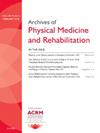Validating a Universal Measurement Scale and Standardized, Reproducible Unit for Gross Motor Development
IF 3.6
2区 医学
Q1 REHABILITATION
Archives of physical medicine and rehabilitation
Pub Date : 2025-07-01
DOI:10.1016/j.apmr.2024.12.008
引用次数: 0
Abstract
Objective
To validate a universal measurement scale and unit for gross motor development across multiple instruments.
Design
Retrospective cohorts.
Setting
Community and clinic.
Participants
Item difficulty calibrations were extracted from 3 published studies. A total of 4445 children from Brazil and Taiwan between the ages of 0 and 77 months with similar percentages of males and females were included (N = 4445). Majority were typically developing children with 655 having atypical development due to a variety of medical conditions.
Interventions
None.
Main Outcome Measures
Gross motor units (GMU) and observed item difficulty calibrations for items on the Peabody Developmental Motor Scales second edition (PDMS-2) locomotor and stationary subscales and the Denver II gross motor subscale.
Results
There was a strong linear association between observed item difficulty for a sample of children with typical development and a mixed sample of typical and atypical development for the PDMS-2 locomotor and stationary subscales, respectively (locomotor subscale, disattenuated r=0.97; stationary subscale, disattenuated r=0.98). GMUs had strong linear associations with observed difficulty for items on the PDMS-2 locomotor and stationary subscales (disattenuated r=0.88-1.00), respectively, when correcting for measurement error. A similar linear association was found between GMUs and observed difficulty for items on the Denver II gross motor subscale (r=0.90).
Conclusions
The results of this study found that GMUs have a strong linear association with observed difficulty for gross motor development items from the PDMS-2 locomotor and stationary subscales and Denver II gross motor subscale. The strong association between observed item difficulties for children with typical and atypical development across multiple scales suggests the GMU and construct specification equation can provide a means for consolidating all gross motor development items onto the same scale.
验证大肌肉运动发展的通用测量量表和标准化,可重复的单位。
目的:验证大肌肉运动发展的通用测量量表和单位。设计:回顾性队列设置:社区和诊所参与者:项目难度校准提取自三个已发表的研究。4445名年龄在0到77个月之间的巴西和台湾儿童被纳入研究,男女比例相似。大多数是正常发育的儿童,655人由于各种医疗条件而出现非典型发育。主要结果测量:大动作单位(GMU)和观察到的项目难度校准在皮博迪发展运动量表-2运动和静止子量表和丹佛II大动作子量表上的项目。结果:典型发展儿童样本的项目难度与典型和非典型发展混合样本的PDMS-2运动和静止分量表(运动分量表,消弱r = 0.97;平稳亚标度,衰减r = 0.98)。在校正测量误差后,gmu与PDMS-2运动和静止子量表(去衰减r = 0.88-1.00)上观察到的难度有很强的线性关联。在丹佛II大运动量表的gmu和观察到的难度之间发现了类似的线性关联(r = 0.90)。结论:本研究的结果发现,gmu与PDMS-2运动和静止分量表以及Denver II大运动分量表中观察到的大运动发展项目的难度存在很强的线性关联。观察到的典型和非典型发展儿童的项目困难之间的强烈关联,在多个尺度上表明GMU和构建规范方程可以提供一种将所有大肌肉运动发展项目整合到同一尺度上的方法。
本文章由计算机程序翻译,如有差异,请以英文原文为准。
求助全文
约1分钟内获得全文
求助全文
来源期刊
CiteScore
6.20
自引率
4.70%
发文量
495
审稿时长
38 days
期刊介绍:
The Archives of Physical Medicine and Rehabilitation publishes original, peer-reviewed research and clinical reports on important trends and developments in physical medicine and rehabilitation and related fields. This international journal brings researchers and clinicians authoritative information on the therapeutic utilization of physical, behavioral and pharmaceutical agents in providing comprehensive care for individuals with chronic illness and disabilities.
Archives began publication in 1920, publishes monthly, and is the official journal of the American Congress of Rehabilitation Medicine. Its papers are cited more often than any other rehabilitation journal.

 求助内容:
求助内容: 应助结果提醒方式:
应助结果提醒方式:


